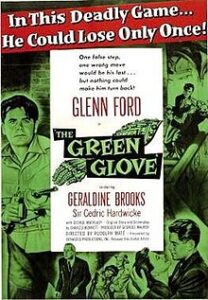The Green Glove *** (1952, Glenn Ford, Cedric Hardwicke, Geraldine Brooks, George Macready) – Classic Movie Review 12,054
The Green Glove (1952) script is by Charles Bennett. The whole stolen bejewelled gauntlet idea is a MacGuffin, which reminds us that Bennett is best known for his work with Alfred Hitchcock.
Director Rudolph Maté’s 1952 French/ American international co-production noir adventure film The Green Glove stars Glenn Ford as Mike Blake, the American World War Two parachuting hero who goes back to France after the war to recover the hidden priceless antique, a bejewelled gauntlet, stolen by Nazi collaborator and art dealer Count Paul Rona (George Macready) from a country church during the war.
The Green Glove is an adequate crime thriller romantic adventure with a strong cast and an impressive production line-up that does not quite achieve the suspense or intrigue that its top credits suggest.
Still, it is quite good fun and satisfyingly pacy and complex, though. Claude Renoir’s location cinematography and Alexandre Trauner’s production designs are first rate – making it a real pity that there is no colour.
The script is by Charles Bennett, based on his novel. The whole gauntlet idea is a MacGuffin, which reminds us that Bennett is best known for his work with Alfred Hitchcock, who first used MacGuffin as a word for a plot device.
Hitchcock took it from an old shaggy-dog story in which passengers on a train interrogate a fellow traveller carrying a strange large package. The passenger says the package contains a MacGuffin, which, he explains, is used to catch tigers in the Scottish Highlands. When the others say there are no tigers in the Highlands, the passenger replies: ‘Well, then, this must not be a MacGuffin.’
It’s all about suspense and how people anticipating a solution to a mystery will continue riveted to the story even if the interest grabber turns out to be irrelevant.
Bennett wrote The 39 Steps (1935) for Hitchcock, then worked on Secret Agent (1936) and Sabotage (1936), Young and Innocent (1937), Foreign Correspondent (1940) and Saboteur (1942). But in The Green Glove, Bennett and director Maté cannot manage the suspense, mystery and romance in the way that Hitchcock can. The elements are all there, ready to be shaken and stirred, but they do not cohere excitingly, and the results are mundane.
It is based on real-life events during Operation Dragoon, and mostly shot on location in southern France and Monaco.
Juliette Gréco sings ‘L’Amour est parti’ and ‘Romance’, both written by Joseph Kosma, with lyrics by Henri Bassis.
The cast are Glenn Ford as Mike Blake, Geraldine Brooks as Christine ‘Chris’ Kenneth, Cedric Hardwicke as Father Goron, George Macready as Count Paul Rona, Gaby André as Gaby Saunders, Jany Holt as The Countess, Roger Tréville as Police Inspector Faubert, Georges Tabet as Jacques Piotet, Meg Lemonnier as Madame Piotet, Paul Bonifas as Inspector, Jean Bretonnière, Jacques Clancy, Roger Legris and Frédéric O’Brady.
© Derek Winnert 2022 Classic Movie Review 12,054
Check out more reviews on http://derekwinnert.com



